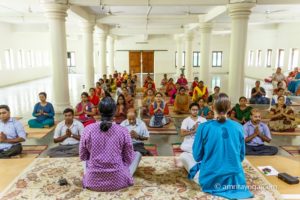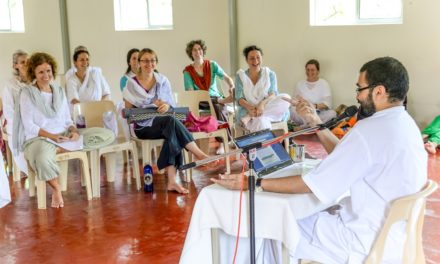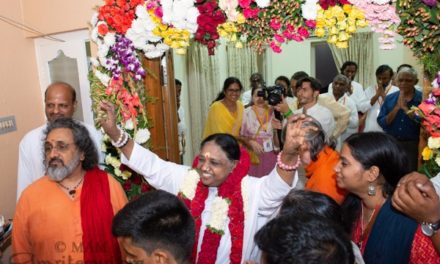 Bhakti and Upasana
Bhakti and Upasana
Editor’s Note: Swami Amritageetananda Puri, one of Amma’s senior-most disciples, gives us valuable insight into Amma’s teachings. Swamiji addresses the question, “what does it mean to express our love for God by worshiping a form of God?” Through his rich stories and metaphors, he describes the play of God between form and the formless and deepens our understanding of form worship in Indian culture. (The term ”upasana” will be explained farther below.)
He also helps us see what values are important to remember when worshiping God in any way, shape or form. Values such as seeing God in everything and offering compassion to our fellow beings are elucidated. He shows us that the form is like a window into the world of the formless supreme consciousness.
Through the stories we see the characters go beyond worshiping an idol placed before them in a limited way, they use their discrimination to see the unlimited divine in the most uncommon and trying circumstances. He shows us the importance of upholding good values on the path towards true devotion and true worship of God in any form.
 Does God have a form? Our answer is—YES, God does have a form. In fact, the entire universe is a manifestation of Bhagavan!
Does God have a form? Our answer is—YES, God does have a form. In fact, the entire universe is a manifestation of Bhagavan!
In my early days in our ashram, we were sitting with Amma when one devotee was telling Amma the story of Swami Dayananda of Arya Samaj. When he was a ten-year-old boy, he was sitting in front of a Siva linga (a formless idol or representation of Siva in the shape of a column of light) in a nearby temple on a Sivarathri (an auspicious day to worship Siva). After some time, a mouse jumped in front of the Siva Linga and started nibbling the naivedyam (food offering to God), that was kept in front of the Siva linga. The boy started thinking, “If this Siva linga is God and He cannot stop a little mouse eating His food in front of him, how can He be all- powerful?” From that day, the boy lost faith and when he grew up, he started preaching against worship of any God with form. When this story was told to Amma, She said, “The boy was ignorant. Why can’t we say that Siva Himself came in the form of a mouse and ate the naivedyam?!”
A Story of True Compassion
There is a pilgrimage in North India in which devotees take pots of water from the holy Ganga River, walk all the way to Rameswaram in Tamil Nadu carrying the pots on their heads and do abhishekam (offerings as an act of worship) on the Siva Linga in Rameswaram Temple. The great Saint Eknath was once with such a group of devotees heading towards South India.  After they walked a long way, they saw that a donkey was lying by the side of the road, dying of thirst. Saint Eknath immediately went to the donkey and poured the Ganga water from his pot into the donkey’s mouth. The other devotees laughed at Eknath and walked away. But after a few minutes, the donkey revealed his true divine form of Lord Siva and blessed Eknath!
After they walked a long way, they saw that a donkey was lying by the side of the road, dying of thirst. Saint Eknath immediately went to the donkey and poured the Ganga water from his pot into the donkey’s mouth. The other devotees laughed at Eknath and walked away. But after a few minutes, the donkey revealed his true divine form of Lord Siva and blessed Eknath!
Last week, there was a traditional dance and narration of the ancient Indian Puranic stories during Amma’s darshan. One of the stories was about the small boy Prahlada who was saved from death many times by Vishnu, an aspect of god representing the sustenance of the universe, in the form of the man-lion known as Narasimha. When Prahlada saw the terrifying form of Narasimha, he was not at all frightened. He knew it was his Lord, Bhagavan Vishnu.

His Guru, Sage Narada, had taught him about a form of Bhagavan Vishnu that is shanthakaram, peaceful; bhujagashayanam, lying on a great serpent; meghavarnam, the colour of clouds; kamalanayanam, lotus-eyed; and shankhu-chakra-gada-hastha, holding the conch, the discus and the mace in His hands, etc. Nonetheless, Prahalada could understand that the appearance of Narasimha was still his own Vishnu in another form.
In September, we celebrated Ganesha Chathurthi (Ganesha’s birthday). We know the story of how Ganesha, when he was asked to go around the world, instead went around His Divine Parents Bhagavan Siva and Mother Parvathi. Sri Ganesha was teaching us that the form we worship represents the entire universe—the one Supreme Being manifested in different forms.
 Worship of Lord Ganesh during the Vinayaka Chathurthi festival is the best example of how one starts from worship of God with form and then slowly goes to the formless infinite nature. From roopam (form) of the Lord to swaroopam (infinite nature) of the Lord.
Worship of Lord Ganesh during the Vinayaka Chathurthi festival is the best example of how one starts from worship of God with form and then slowly goes to the formless infinite nature. From roopam (form) of the Lord to swaroopam (infinite nature) of the Lord.
From Murthi Puja, worship of an idol or form of the Lord, one goes to Keerthi Puja, the glory of the Lord; understanding that all forms and powers in this universe are the powers of God.
During the celebration of Ganesha Chathurthi we install an idol of Lord Ganesha made of mud or clay, worship it for a few days, then do the visarjanam, (immerse the idol in the ocean). The ocean represents the Supreme Being, vast, deep and immeasurable. The idol dissolves and becomes one with ocean, symbolizing the form of God we worship merging into the all-pervading nature of God.

The Deeper Meaning of Upasana
Worship of God with form is called upasana and contemplating on His infinite nature is called nidhidhyasana. Upa means “near” or “by the side of” and asana means “sit” or “remain.” Upasana in short means constantly “remaining near” or constantly thinking of our Lord. It is almost the same as upavasam (means fasting but literally means “staying near the Lord.)” During fasting, if we constantly think of food, then it is not upavasam. Staying mentally near the Lord is upasana or upavasam. And this is what is really meant by bhakti or devotion.
Now, how does bhakti lead to jnana or knowledge? Remember the times when we first went to Amritapuri. I had read Amma’s biography Mother of Sweet Bliss. After I went there, within a short time, I asked and found out everything about Amma—Amma’s family members and their names, the places where She meditated, the route of 11 kms Amma used to walk from Her grandmother’s house to Her home, the school where She studied. . . everything about Amma! So too when we worship the form of our Lord, we want to know more and more.  Our knowledge ends with knowing Amma or the Lord as the core of our being, residing in our hearts and giving life and nourishment to all our senses, organs and mind.
Our knowledge ends with knowing Amma or the Lord as the core of our being, residing in our hearts and giving life and nourishment to all our senses, organs and mind.
Our scriptures lead us from form to formless—remind us that the form we worship in front of us is in reality within us. The form comes and goes, but its real nature is always there, permanent. Our Lalitha Sahasranama (the Thousand Names of the Divine Mother) is a very good example—guiding us from form to formless.
“Om Sri matha Namaha” – Prostrations to Lalitha in the form of the auspicious Mother
“Om Sri Maha rajnyai Namaha” – Lalitha in the form of the Empress of the Universe
“Om Sri math Simhasaneshvari Namaha ” – Lalitha who is the Queen of the most glorious throne or who is in the form of the Goddess seated on the most glorious lion
“Om Chid agni kunda Sambhoothayai Namaha” – Who was born in the fire pit of Pure Conciousness or She who arose from the fire of Consciousness or the formless Consciousness within us
 Thus, we see that our Guru Amma and the scriptures guide us from the form of the Lord to His Formless Infinite Nature.
Thus, we see that our Guru Amma and the scriptures guide us from the form of the Lord to His Formless Infinite Nature.
Value education is a very important part of our syllabus, both in primary school and college, teaching us how to cultivate good qualities and habits. Upholding good values is also a form of worshiping the divine.
Modern psychology has a method called auto-suggestion to help us replace our negative tendencies like anger, fear, or lack of confidence with positive qualities like patience, courage and confidence. In the night after we lie down to sleep, slowly we go on thinking in our minds, “I am patient, I am patient, I am patient.” We fall asleep with this thought, and our subconscious mind goes on chanting this in deep sleep and we slowly change for the better.
This method that psychology recently discovered has been practiced by us in the form of “bed time stories” for thousands of years. Our parents and grandparents narrate to us stories of Sri Ram and Sri Krishna and we slowly glide into sleep with these thoughts of “Sri Ram” and “Sri Krishna” who were truthful, patient, courageous, compassionate….!” We wake up changed for the better!
 A salesman/woman is always smiling and patient, but the motive is, “I want to get my sales commission.”
A salesman/woman is always smiling and patient, but the motive is, “I want to get my sales commission.”
Amma’s Smile
Amma’s smile is different. Her love and compassion come from Her universal divine vision. Amma is a siddha (an already accomplished being); we are sadhakas (seekers on the spiritual path). The siddha’s nature and qualities become our sadhana (spiritual practices that help us attain good qualities). For Amma, smiling and compassion are spontaneous and effortless. For us, they are conscious effort—this is called sadhana.
 Most of us are hero/heroine worshippers. In modern language, we call it “fans.” The youngsters are fans of film stars, cricketers, millionaires, etc. They imitate their hero’s/heroine’s way of dressing, walking, hairstyle, etc. So too, our heroes are Sri Ram and Sri Krishna and we worship them and follow their lifestyle and cultivate their good qualities like humility, patience, compassion, courage, etc.
Most of us are hero/heroine worshippers. In modern language, we call it “fans.” The youngsters are fans of film stars, cricketers, millionaires, etc. They imitate their hero’s/heroine’s way of dressing, walking, hairstyle, etc. So too, our heroes are Sri Ram and Sri Krishna and we worship them and follow their lifestyle and cultivate their good qualities like humility, patience, compassion, courage, etc.
We worship Amma because She is the very embodiment of infinite peace and joy that everyone of us seek. This is the real upasana. We are like wet wood; Amma is like fire. When we constantly sit near Amma, like wet wood near fire slowly drying and catching fire, so too our closeness with Amma helps us develop all good qualities. This is the logic behind worship of God with form. By striving to uplift ourselves to emulate the good values expressed by the form of God we worship, we become the very expression of that form and the good values embodied by it.
We pray to Amma to take us from Her form to Her infinite nature.
Swami Amritageetananda Puri
As always, thoughtful comments are invited and appreciated. Share your reflections with us! See below to leave a comment.





